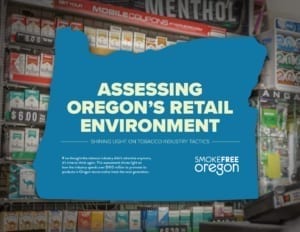HOOKING THE NEXT GENERATION
The tobacco industry doesn’t wait for a child to grow up. They know that the younger someone starts to use tobacco, the harder it will be to quit. Nearly 90 percent of people who smoke start before they turn 18.1 Teenagers’ developing brains are vulnerable to the highly addictive nicotine in tobacco products.2
The truth is, where you see a young person, tobacco companies see a “replacement smoker.”3
That’s a direct quote from an R.J. Reynolds research report. Thousands of people in Oregon die from tobacco every year.4 The tobacco industry needs someone to take their place.
OUR KIDS: BIG TOBACCO’S TARGET FROM AN EARLY AGE
The tobacco industry starts early, reaching kids with sponsorships at fairs and car races they attend with mom and dad. Smoking is still common in youth-rated movies.5 For decades, the tobacco industry used child actors, celebrities and cartoons like Joe Camel to make smoking seem totally normal to youth. Once the industry was banned from using cartoons, it shifted its youth marketing money into video games, movies, social media and all over convenience stores where youth gather.6
Can tobacco companies market to kids?
Not legally, but…
In Oregon stores that sell tobacco, the industry places ads for its products below 3 feet (eye level of a child), and places the products themselves within 12 inches of candy, mints or gum.15
What kinds of tobacco products are Oregon teens using?
Use of e-cigarettes by teens increased 80 percent from 2017 to 2019.12
About 24 percent of Oregon 11th graders use non-cigarette tobacco products16 (smokeless tobacco including chew, dip, snuff and snus; cigars and little cigars, hookah tobacco, and e-cigarettes).
Approximately 5 percent of 11th-graders smoke cigarettes.16
STORES THAT SELL TOBACCO: THE NEW BATTLEGROUND
But that’s nothing compared to what the tobacco industry has done to the average small grocery, convenience store or gas station. Banned from many other forms of advertising, the tobacco industry has shifted its millions of marketing dollars to the “powerwall” displays of products and price promotions right behind the checkout counter. About half of Oregon teens shop in convenience stores at least once a week,7 so the tobacco industry spends about one million dollars per hour promoting their products in stores, nationwide.8
Studies show stores located near schools have more outside ads for tobacco than stores farther away. Stores where teens shop more often have more cigarette marketing than others in the same community.9
Inside, children and teens see tobacco ads and products displayed at a child’s eye level or near the candy. And the tobacco industry keeps prices low with coupons and payments to retailers.
Among Oregon 8th graders, about a quarter feel that it would be easy to get e-cigarettes or other vaping products if they wanted to.
Half of 11th graders feel the same.
SWEET, CHEAP AND EASY TO GET
The number of sweet-flavored tobacco products marketed to youth has exploded in recent years. Flavors, such as “vivid vanilla” and “cherry crush,” mask the natural harshness and taste of tobacco, making it more appealing to kids and young people.
Flavored products include:
- E-CIGARETTES OR VAPE. E-cigarettes are marketed in kid-friendly flavors such as cotton candy, strawberry and chocolate. They are the way many youth first get addicted to nicotine.10
- FLAVORED LITTLE CIGARS OR CIGARILLOS. These are cheap and easy to get. They are sold one or two at a time, often for less than a buck each.11
- SMOKELESS TOBACCO. Chew, snuff, snus, and dissolvable sticks and strips also come in sweet fruit flavors. Some varieties, like mint-shaped “orbs,” are easily mistaken for candy.
These candy-flavored tactics are paying off. Even as cigarette use declines among Oregon teens, the use of flavored tobacco products is on the rise. In 2015, e-cigarettes and vapes surpassed cigarettes as the most popular tobacco product among Oregon youth.12 E-cigarette use among 11th graders went up 80 percent from 2017 to 2019.13 In 2019, one in four Oregon 11th graders used an e-cigarette, compared to only one in 20 who used cigarettes.12
EASY ACCESS TO TOBACCO
On January 1, 2018, the legal purchase age for tobacco in Oregon increased from 18 to 21 years of age. Early results suggest that the law is making a difference and protecting Oregon teens.
However, in 2019, nearly one in six Oregon tobacco retailers illegally sold tobacco to a buyer under the age of 21.14 Even more retailers made illegal sales of the products most popular with youth: More than one in five inspected retailers illegally sold e-cigarettes, and more than one in four illegally sold little cigars.14
To hold retailers accountable, some counties in Oregon are requiring a license to sell tobacco.

